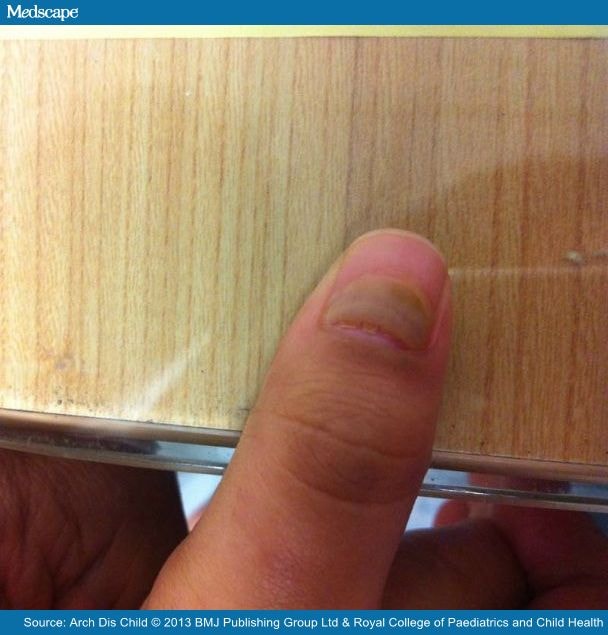Nail Shedding Following Hand, Foot and Mouth Disease
Arch Dis Child. 2013;98(9):665
A previously well 5-year-old Chinese girl presented to the children's emergency with nail discolouration of 5 days duration. There was no associated pain or history of trauma. She had otherwise just recovered from hand, foot and mouth disease (HFMD) 3 weeks ago. On examination, there was separation of the nail plate from the nail bed, beginning at the proximal nail fold, affecting both thumbs and big toes (figure 1). No other cutaneous lesions were noted, and general examination was unremarkable. The diagnosis of onychomadesis was made, and her parent was reassured that no treatment was required.

Figure 1.
Patient's right thumb showing onychomadesis.
Onychomadesis is defined as a painless spontaneous separation of the nail plate from the bed, beginning at the proximal end with subsequent shedding of the nail as the new nail grows. It can occur idiopathically, after trauma, or in association with serious systemic illnesses, infections and drugs reactions.[1,2] The association between onychomadesis and HFMD was first proposed by Clementz et al,[3] with recent studies of HFMD outbreaks in Spain and Finland providing further supporting evidence.[4]
Onychomadesis occurs as a result of temporary arrest of nail growth at the nail matrix. Other possible mechanisms of onychomadesis in HFMD include inflammation of the nail matrix and intensive hygienic measures resulting in maceration, Candida infection and allergic contact dermatitis.[5] No treatment is required for onychomadesis, and onward referral to specialist is unnecessary. Patients should be reassured that spontaneous regrowth of a new normal nail is usually seen within a few months.
Δεν υπάρχουν σχόλια:
Δημοσίευση σχολίου